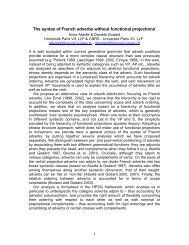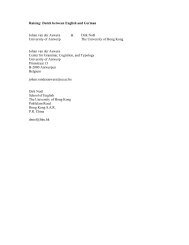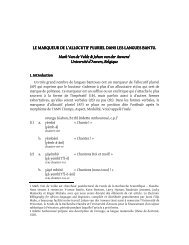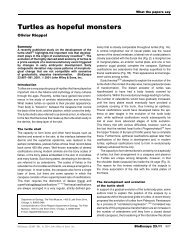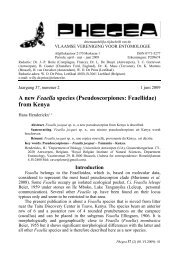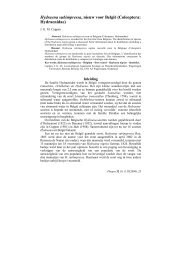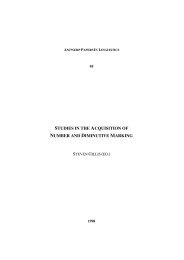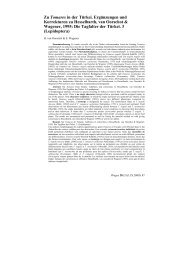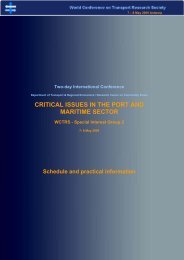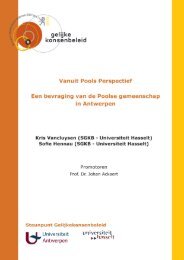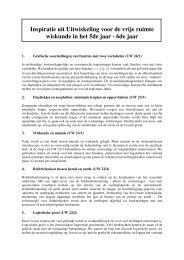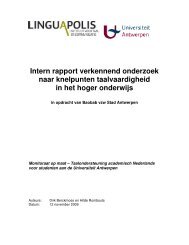Theodor2005.pdf
Theodor2005.pdf
Theodor2005.pdf
You also want an ePaper? Increase the reach of your titles
YUMPU automatically turns print PDFs into web optimized ePapers that Google loves.
174 Theodor and Foss<br />
dp3 is not as high, and the hypoconid and paraconid are larger and blunter than on dp2. The<br />
hypoconid is distal and slightly lingual to the protoconid, and the entoconid is very tightly<br />
appressed to it—with wear it appears to be merged with the hypoconid, presenting a wider,<br />
more ovate wear facet. The crown is wider buccolingually than dp2, and the mesiodistal<br />
crest and buccal cingulid are more distinct. The protoconid and hypoentoconid are joined<br />
by the cristid obliqua. The talonid is complex, and larger and projects more to the lingual<br />
side than on dp2. The crown is deeply basined between the mesiodistal crest of the tooth<br />
and a more lingual crest borne on the lingual side of the hypoentoconid. Distal to the<br />
hypoconulid, the mesiodistal crest appears to split, causing the hypoconulid to appear as a<br />
cuspate junction of these three crests. The crests form a deep basin, ringed with one or two<br />
additional accessory cuspids, the lingual and buccal posthypoconulids, of which the buccal<br />
is only well-developed on EBA327. The talonids are worn on most of the specimens, so the<br />
presence of a buccal posthypoconulid on the other specimens cannot be established. The<br />
ectostylid is absent.<br />
dp4: The dp4 resembles that of other artiodactyl taxa, bearing the distinctive 6-cusped<br />
morphology (Luckett and Hong, 1998), squaring off the mesial end with a small pseudoparaconid.<br />
There are no clear differences between the dp4’s of the two genera, but all of<br />
the dp4’s show some degree of wear that might obscure any differences.<br />
Phylogenetic Results<br />
We found 148 shortest trees at 669 steps (CI = 0.288, RI = 0.592, RC = 0.171, HI =<br />
0.732). A strict consensus of the 148 shortest trees and the support metrics for each node<br />
is presented in Fig. 5 (see Tables I and II and Supplementary Information). The consensus<br />
of the shortest trees shows several important areas of conflict between our analysis and the<br />
results of Geisler and Uhen (2003) and Thewissen et al. (2001).<br />
Our analysis shows a monophyletic Cetartiodactyla, consistent with Geisler and Uhen<br />
(2003, 2005) and Thewissen (2001), with a monophyletic Artiodactyla, in agreement with<br />
Thewissen (2001) and Geisler (2001a) but not with Geisler and Uhen (2003, this volume)<br />
and Boisserie et al. (2005). This may be a result of our inclusion of a number of ankle characters<br />
from Thewissen (2001), our new dental characters, from the inclusion of additional<br />
taxa drawn from basal artiodactyl lineages, or our choice of outgroups. Clearly additional<br />
character data are needed to resolve the issue of artiodactyl monophyly.<br />
Our analysis also supports the monophyly of Selenodontia, supporting Gentry and<br />
Hooker’s (1988) results, but it is important to note that very few ruminant taxa were included,<br />
as we did not expect them to contribute to resolving the position of the more basal parts of<br />
the tree. Our results also show some groupings, especially among the selenodonts, that are<br />
unorthodox, and weakly supported, such as the paraphyly of Protoceratidae, Oreodontoidea,<br />
Ruminantia, and even Suidae and Tayassuidae. We suspect that this is a result of two factors:<br />
low taxon sampling within these groups, and we may have omitted characters that would<br />
have supported the monophyly of these groups. These regions of the tree are likely to be<br />
very sensitive to additional data.<br />
The basal position of leptochoerids in our analysis is similar to the basal position<br />
reported by Gentry and Hooker (1988), where the family was the sister-taxon to Diacodexis<br />
metsiacus (here referred to D. secans). Many other analyses of basal cetartiodactyl



